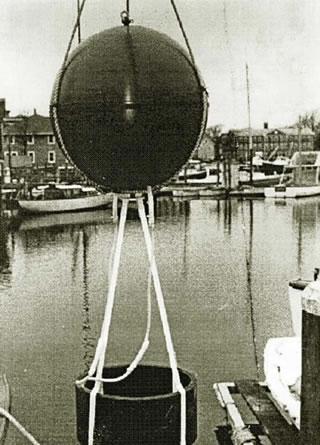SOFAR floats
Work continued on the floats with improvements to design and tracking
methods. The lifespan of floats was increased (from ~5 days to ~50 days) through
switching from continual sound signal transmission to intermittent signals
(Swallow and Hamon, 1960). However, floats would need to be tracked for much
longer than weeks if they were to provide insight into mean ocean circulation.
Major developments were made in the late 1960s and early 1970s. The first was the development of floats that transmitted a low-frequency sound (500-600 Hz) that could be tracked through the SOFAR channel (Rossby and Webb, 1970); an evolved version of Stommel’s initial idea. Trials using the US Airforce’s shore-based array of hydrophones demonstrated that float positions could be tracked across most of the northwest Atlantic over ranges of up to 1000 km to within 3-5 km.

Prototype SOFAR float in Woods Hole in the late 1960s. (Photo courtesy of Tom Rossby). The sphere housing the electronics and battery has a diameter of 1m, with the transducer hanging below. See Rossby & Webb 1970.
The successful trials of the SOFAR floats led to the Mid-Ocean Dynamics
Experiment (MODE; MODE Group, 1978). During this experiment an array of MODE
SOFAR floats designed to drift at 1500 m for 1 year were deployed and tracked by
hydrophones in Bermuda, Bahamas, Grand Turk and Puerto Rico that recorded their
low frequency (~270 Hz) signals. The experiment was remarkably successful with
some of the floats lasting 2 years.
However, this approach had the
drawback that floats were restricted to particular depth horizons and so
vertical current structures could not be resolved. With improvements to float
electronics, Swallow was able to develop the ‘MiniMODE’ system (Swallow et al.,
1974). This ship-based system allowed an array of floats with transponders to be
tracked simultaneously as each had their own assigned frequency (5.0-6.5 kHz
range). Through this array current structure could be observed over wider depth
ranges within 70 km of the ship. Tracking was later achieved through use of
master and slave floats instead of a ship. While SOFAR floats marked a
significant progression in float evolution, at this time data were still largely
restricted to mesoscale oceanographic features.